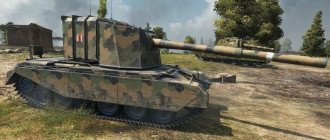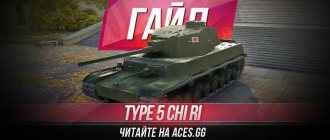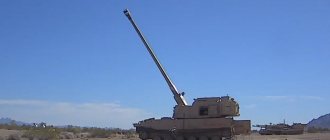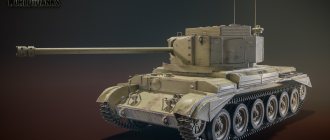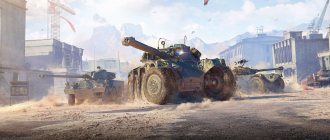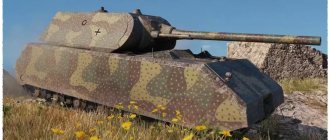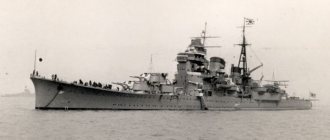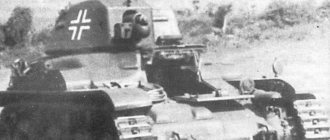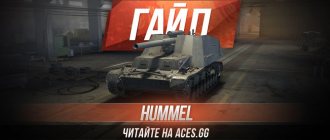"Chi-Ro" redirects here. Not to be confused with Chi Rho or Chiro.
weapon
| Type 89 I-Go (Chi-Ro) | |
| Restored Type 89 I-Go at Tsuchiura JGSDF Base open day | |
| Place of origin | Japanese Empire |
| Production history | |
| Developed | 1928 |
| No built | 404 [1] |
| Characteristics | |
| Weight | 12.79 metric tons (14.10 short tons) |
| Length | 5.73 m (18 ft 10 in) |
| Width | 2.15 m (7 ft 1 in) |
| Height | 2.56 m (8 ft 5 in) |
| Crew | 4 |
| Armor | 6 to 17 mm (0.24 to 0.67 in) |
| Main weapons | 57 mm Type 90 cannon, 100 rounds [2] |
| Secondary weapons | 2 x 6.5 mm Type 91 machine gun (hull, turret rear) 2,745 rounds [2] |
| Engine | Mitsubishi A6120VD, in-line 6-cylinder air-cooled diesel engine, 120 hp. (90 kW) / 1800 rpm, 14,300 cc |
| Suspense | leaf spring |
| Operating range | 170 km (110 mi) |
| Maximum speed | 26 km/h (16 mph) |
89 medium tank I-Go
(八九式中戦車イ号, Hachikyū-shiki chu-sensha I-go) was a medium tank used by the Imperial Japanese Army from 1932 to 1942 in combat operations of the Second Sino-Japanese War at Khalkhin Gol against the Soviet Union and during Second World War .
The Type 89B was the world's first production tank with a diesel engine. [3] The tank was armed with a short-barreled 57 mm cannon for knocking out pillboxes and stone fortifications and proved effective in campaigns in Manchuria and China, since the Chinese National Revolutionary Army had only three tank battalions to counter them, which consisted mainly of Vickers export models, German tank islands and Italian CV33 wedges. [4] The Type 89 was a medium tank of a 1920s design, built for infantry support, and therefore did not have the Allied armor or armament of the 1940s generation; it was considered obsolete by the time of the 1939 battles of Khalkhin Gol against the Soviet Union. [5] The codename "I-Go" is derived from the katakana
[イ], meaning "first", and
the kanji.
[号] for "number".
The designation is also transliterated Chi-Ro
and sometimes "Yi-Go". [6] [7]
History and development[edit]
Experimental tank No. 1 (試製1号戦車), 1927 (2587 imp.)
The Type 89 evolved from the first Japanese tank project initiated by the Osaka Technical Arsenal of the Imperial Japanese Army in 1925. The original plan called for the creation of two types of tanks. A 10 ton light tank based on the French Renault FT tank and a 20 ton tank modeled after the Vickers medium tank. [8] By February 1927, the Type 87 Chi-I medium tank was ready for testing. However, it was 20 tons and underpowered. [9] The weight of the first prototype and its low speed did not impress the Imperial Japanese Army General Staff, and a new requirement was issued for a lighter tank with a nominal weight of 10 short tons (9.1 metric tons). The new design was modeled after the Vickers Medium C, which was purchased by the Japanese Army in March 1927. [10]
By April 1928, the project for a new light tank was completed. The prototype of the Type 89 light tank (試製八九式軽戦車1号機) was completed in 1929 and designated Type 89. [7] The Type 89 was later reclassified as a "medium tank" due to its weight having increased to over 10 tons through a number of improvements. Since the Sagami Army Arsenal lacked the capacity for mass production, the contract was awarded to Mitsubishi Heavy Industries, which built a new tank factory to produce the model. [7] Production of the Type 89 began in 1931, and it soon became the main battle tank of the Japanese Army. [eleven]
Although the Type 89 was well regarded by the Army, several minor problems needed to be corrected, notably a gap under the mantlet on early models that allowed rifle fire to enter the turret. After production began, work on improving the Type 89 continued, resulting in variants being developed. [5]
PTZ-89: Beijing-style tank destroyer
The aggravation of relations between the USSR and the PRC, the apotheosis of which was the conflict over Damansky Island in 1969, clearly showed that a full-scale war between the two socialist states is quite likely. The Chinese military-political leadership was well aware of the technical superiority of the Soviet army (both qualitatively and quantitatively). In search of ways to compensate for their lag, the Chinese turned to asymmetric measures. One of the ways to combat the tank threat from the north was the development of the concept of a cannon tank destroyer, which led to the adoption of the PTZ-89
.
PTZ-89 division in the park topwar.ru
During World War II, tank destroyers became one of the main classes of armored vehicles. Armed with powerful guns, mobile and tolerably protected, they were an effective means of combating enemy tanks. However, in the post-war years, this class lost popularity: increased armor protection of tanks, coupled with the development of anti-tank missile systems, quickly negated the role of cannon tank destroyers. A few exceptions, like the West German Kanonenyagdpanzer, only confirmed the rule. Only light tank destroyers, intended for use in special conditions, have received some development - both with conventional guns (American M56 Scorpion) and with recoilless guns (American M50 Ontos, Japanese Type 60). On the other hand, the idea of a cannon tank destroyer looked very tempting as a simple and inexpensive alternative to technologically complex ATGMs. In this aspect, it attracted the attention of the Chinese military. However, the first attempt to create a tank destroyer with recoilless rifles was not successful - the WZ-141, although it took quite a long time to be finalized, did not enter service. More successful (although no less time-consuming) was the development of a self-propelled gun with a conventional smoothbore gun.
Gun problem
The key issue when creating a tank destroyer was the choice of weapons. Chinese industry produced a 100-mm rifled tank gun (a copy of the Soviet D-10T2S), but its power clearly did not meet the requirements of the second half of the 70s. The study of the U-5TS gun from the T-62 tank captured at Damansky pushed Chinese design thought in the right direction: a smoothbore gun was needed that fired armor-piercing finned sabot projectiles (BOPS). The Chinese tried to acquire technology for the production of 120-mm guns in Germany, but as a result they had to rely on their own strength.
In 1978, the People's Republic of China approved a program for the development of a 120-mm smoothbore gun intended for advanced tanks. The key requirement was the ability to destroy the T-72 tank with an armor-piercing finned sabot projectile at a range of 2000 m. Already in 1979-1980, testing of prototype guns created by plant No. 447 began. Such a short time frame for creating the gun suggests that the Chinese still managed to gain access to Western technologies. The test results were generally positive.
Prototype tank destroyer PTZ-89 army-guide.com
In the early 80s, China managed to purchase a copy of the export version of the T-72 tank in the Middle East. This led to a change in priorities: now a 125-mm gun, copied from the 2A46, was created for the main battle tank. However, the Chinese did not put all their eggs in one basket, and continued to fine-tune the 120 mm gun. Now it was considered as a weapon for a tank destroyer.
In 1983, testing began on an improved version of the 120 mm gun with a barrel length increased to 52 calibers (the West German prototype and, probably, early versions of the Chinese gun had a barrel length of 44 calibers). The gun showed good performance: its BOPS penetrated 460 mm of homogeneous rolled armor at a distance of 2000 m. At the same time, the recoil force of the gun made it impossible to realize the original plan: to create a tank destroyer on the chassis of the Type 62 light tank. A reinforced chassis was required, preferably one already in mass production. And we managed to choose this option.
Implementation of the concept
A suitable option was the WZ-321 tracked chassis, created for the PLZ-83 152-mm self-propelled howitzer and subsequently also used in the PHZ-89 multiple launch rocket system. It could easily withstand the recoil of a 120 mm cannon. The WZ-321 had another advantage - unification with other types of Chinese artillery (the new tank destroyer was positioned specifically as artillery weapons).
Testing of a tank destroyer on the WZ-321 chassis began in 1984. A year later, the self-propelled gun was first demonstrated to a limited circle of officials. It was adopted into service in 1989 as the “Type 89”. Already in the new century, with the introduction of a unified designation system, the self-propelled gun was dubbed PTZ-89 (Pao Tujiche Zixing - self-propelled assault artillery system).
The gun mounted on the PTZ-89 is equipped with an ejector and a heat-insulating casing army-guide.com
The tank destroyer completely retained the layout of the base vehicle with a front-mounted engine and transmission compartment and a circular rotation turret shifted to the rear. The control compartment with the driver's workplace (displaced to the left side) is located between the engine and transmission and combat. Three more crew members (commander, gunner and loader) are located in the turret. The design of the hull and turret is welded, made of steel armor plates with a maximum thickness of 50 mm (turret) and 10 mm (hull). Access to the fighting compartment is through hatches in the turret roof and a single-leaf door in the rear wall of the hull (also used for loading ammunition).
The self-propelled gun is equipped with a 12-cylinder diesel engine WR-4B (a copy of the German Deutz 12150L engine) - liquid cooled, turbocharged, developing a power of 520 hp. The transmission is mechanical, planetary type. The specific power is 16.75 hp/t, which provides the self-propelled gun with good mobility. The maximum speed is 55 km/h, the range on the highway is 450 km. The chassis for one side includes a front drive wheel, a rear tension wheel, six road wheels with torsion bar suspension and three support rollers. A characteristic feature of the chassis is the uneven arrangement of the road wheels: the distance between the 1st and 2nd, 3rd and 4th, as well as the 5th and 6th rollers is noticeably greater than between the 2nd and 3rd, as well as 4th and 5th.
PTZ-89 can only fire from a location army-guide.com
The main armament of the PTZ-89 is a 120-mm smoothbore gun, equipped with an ejector for removing powder gases and a heat-insulating casing. The ammunition consists of 30 (according to other sources, out of 36) unitary rounds, some of which are located in the ammunition rack in the rear niche of the turret, and some in the rear of the hull. Some publications mention the presence of a “semi-automatic loading system” on the PTZ-89, but in essence we are talking about an electrically driven rammer. The stated rate of fire is 10 rounds/min. Auxiliary weapons include a 12.7 mm QJC-88 anti-aircraft machine gun mounted on a turret above the hatch. Some publications mention the presence of a 7.62 mm machine gun coaxial with a cannon, but this weapon is not present in photographs of the PTZ-89. There is no weapon stabilizer, so the PTZ-89 can only fire from a standing position.
The gun's ammunition includes three types of projectiles: armor-piercing finned sub-caliber, cumulative and high-explosive fragmentation. The initial speed of the BOPS is 1660 m/s, the cumulative projectile is 960 m/s, the effective fire range of the BOPS is 2500 m, the high-explosive fragmentation projectile is 9000 m. The PTZ-89 uses the TSFCS-C fire control system from the Type 79 tank. , in the basic version including a day sight, a laser rangefinder and a ballistic computer. The SPG commander has a simplified daytime sight.
A PTZ-89 self-propelled gun battery during an exercise slide.mil.news.sina.com.cn
PTZ-89 has two blocks of smoke grenade launchers (four barrels each) located in the front part of the turret, as well as thermal smoke equipment that provides a smoke screen by injecting fuel into the engine exhaust tract. The self-propelled gun is equipped with a system of protection against weapons of mass destruction and a high-speed fire-fighting system.
Production and service
It is believed that serial production of the PTZ-89 tank destroyer began back in 1988, and by 1989 the army received the first batch of two dozen self-propelled guns. Serial self-propelled guns differed from the prototypes in a slightly modified turret shape. The total production volume is unknown: in various sources it ranges from “a little over a hundred”
up to 230 copies. In any case, the production rate was low and did not exceed 15-25 cars per year.
Another batch of PTZ-89 leaves the plant weaponsystems.net
During modernization in the 90s, a night channel was introduced into the fire control system of the PTZ-89 self-propelled gun. A new BOPS has also appeared, whose tungsten core is capable of penetrating 550 mm of steel armor at a distance of 2000 m (the original version of the projectile penetrated 460 mm of armor). Attempts were also made for deeper modernization by installing a gun with a barrel extended to 58 calibers (its BOPS provided armor penetration of 700 mm at a distance of 2000 m). However, this version of the tank destroyer was not introduced into mass production.
Self-propelled gun PTZ-89 during training at the training ground topwar.ru
As we have already noted, the PLA tank destroyer PTZ-89 was considered an artillery weapon. The organization of units armed with such self-propelled guns was also appropriate. Three-battery divisions (18 self-propelled guns each) were added to the artillery regiments of a number of tank divisions of the Beijing and Jinan military districts. However, the service of the PTZ-89 turned out to be relatively short-lived - on November 5, 2015, this vehicle was officially removed from service.
Why did PTZ-89's career end so quickly? Probably the reason was the intensive development of tank building in the PRC, as a result of which the PLA received a sufficient number of tanks - both main combat and light ones. As a result, a tracked combat vehicle with tank armament, but not being a tank, turned out to be simply unnecessary. At the same time, the PRC continues to develop wheeled tank destroyers - armored vehicles with heavy cannon armament.
Ceremony for decommissioning the PTZ-89 self-propelled gun in one of the artillery regiments of the 39th Army Group slide.mil.news.sina.com.cn
Tactical and technical characteristics of the PTZ-89 self-propelled gun
| Combat weight, t | 31 |
| Crew, people | 4 |
| Armament (ammunition) | one 120 mm cannon (30 rounds), one 12.7 mm machine gun |
| Dimensions, mm: | |
| length height width | 8240 3230 2800 |
| Engine power, hp | 520 |
| Maximum speed, km/h | 55 |
| Cruising range, km | 450 |
Literature:
- army-guide.com
- topwar.ru
- weaponsystems.net
- army-guide.com
- sinodefence.com
Design[edit]
Medium tank Type 89 Ko early model.
The Type 89 required a crew of four (commander/gunner, loader, driver and hull gunner).
The Type 89 design was relatively conventional with a forward-mounted gun turret carrying the main armament, a 57 mm Type 90 cannon, which was complemented by two 6.5 mm Type 91 machine guns. [2] One was located at the front of the hull, and the other was located in the rear-facing turret ball joint, a practice followed by most Japanese tanks. [12] The 57 mm Type 90 tank gun had a barrel length of 0.85 m (33 in) (L14.9), firing angle from –15 to +20 degrees, AZ firing angle of 20 degrees, muzzle velocity of 380 m /s (1,200 ft/s) and could penetrate 20 mm of armor at 500 m (0.8 in/550 yd). In the later stages of World War II, HEAT rounds were developed to provide greater penetration of enemy armor. [13]
Rather than using soft iron armor as on the earlier Chi-I, the designers decided to use steel plate armor developed by Nihon Seikosho (JSW). The type of armor was called "Niseko steel", short for "Nihonseikosho". [14]
The Type 89 was driven via a rear drive sprocket and had nine bogies, mounted in pairs on each side, with the front bogie being independently suspended. Five smaller return wheels were installed along the steel beam. [15] Type A could only communicate with signal flags. [15] Some vehicles were equipped with two searchlights for night operations. Later Type 94 Mk 4 Hei (1934 model) radio communications device with a range of 0.97 km (0.6 mi) and a mass of 90 kg (198 lb), coupled to an 8.99 m (29 ft 6 in) long radio antenna in in the opposite direction. The L-shape was installed.
Best sniper weapon
This is a very specific class. Not everyone likes to play as a sniper, which is due to the low-dynamic gameplay. But he is capable of destroying targets from a great distance, which gives him an advantage in such skirmishes over any other class in the game.
To determine the best weapon for a sniper, you need to pay attention to its main characteristics: damage per shot, speed of entry into aiming mode, and rate of fire.
DVL-10 M2
This rifle is one of the best options for a sniper in Warface. It allows you to kill any enemy, except SED, with one cartridge, since it ignores protection from one hit in absolutely any body armor.
The DVL also has a fairly high rate of fire by sniper standards and a good magazine capacity. In addition, this rifle has unique modules: bipod, flash suppressor and muzzle brake. They reduce the speed of changing weapons, recoil and the speed of entering aiming mode, which gives an advantage over other snipers:
The only negative is the lack of a muffler. Therefore, you should pay attention to the mini-map, and also change your position more often.
SV-98
This is a Russian sniper rifle that fires single shots with the bolt jerking. It does not have the disadvantages of the previous version, and a silencer can be installed on this weapon. It will reduce damage, but even with it the rifle will kill the enemy with one shot.
The SV-98 enters aiming mode fairly quickly and has a good rate of fire for such rifles. In addition to unique modules, you can also install standard ones.
The game also has semi-automatic sniper rifles, but they are not suitable for playing against real players. They are best used in special operations.
The best weapons may change with the next update, so it would be a good idea to try them out for yourself. This will make it much easier to determine your priority option.
start playing Warface on the official website.
Author of the selection: s7yfox
Options [edit]
- Type 89A I-Go Kō
(八九式中戦車 (甲型)) - The initial production model had a water-cooled Daimler engine producing 100 hp. (75 kW) (ダ式一〇〇馬力発動機, da-shiki hyaku-bariki hatsudōki) 6-cylinder gasoline engine and mounted machine gun on the right side of the hull. [7] This design could only reach speeds of 15.5 km/h and was also limited by the harsh winter climate in northern China. A total of 113 tanks were produced. [16]
Top view of the Type 89B I-Go Otsu
- Type 89B I-Go Otsu
(八九式中戦車 (乙型)) -
The Ko
was replaced in production from 1934 by the
Otsu
, powered by a 120 hp air-cooled Mitsubishi A6120VD diesel engine.
(89 kW). [7] The improved model had a new "asymmetrical profiled" gun turret complete with a dome for the commander, and with a machine gun relocated to the left side of the hull. [11]Multiple armor plates on the frontal part of the hull were replaced with a single flat frontal armor plate, providing additional protection for the driver. However, the main difference between the versions was Mitsubishi's 6-cylinder air-cooled diesel engine, which had several advantages: less fire susceptibility than the gasoline engine, better fuel economy, and more torque at lower revs. The Japanese Army also preferred the diesel engine because more diesel could be produced per barrel of oil than gasoline. Otsu
tanks were produced . [17] The Type 89B Otsu version was the first production tank to use a diesel engine. [7]
Type 89B I-Go Otsu
This modification appeared in 1934. The engine on this tank was again replaced. This tank again features the Mitsubishi A6120VD diesel engine. But, as far as I understand, it is fairly modernized. And the Japanese decided to return to him again.
They also began installing a new design gun turret on the tank. It featured a special observation dome for the tank commander. And the machine gun moved from the right side of the front hull to the left.
Type 89B tanks in the Philippines.
History of battles[edit]
Japanese tanks move towards Manila, January 1942.
The Type 89 served in Japanese infantry divisions and was first used in combat during the First Battle of Shanghai in 1932. [18] The short-barreled 57 mm cannon was effective at destroying machine gun nests and its 15 mm (0.59 in) armor, although thin, was sufficient to stop small arms fire. The relatively low speed of 25 km/h (16 mph) was not a problem for such operations. [14]
The following year, the Japanese Army formed its first separate tank detachment, creating three regiments armed with the Type 89 [3], each consisting of two companies of ten tanks each. Three more regiments were formed in 1934. It was used in infantry support during the Second Sino-Japanese War and in various campaigns throughout China after 1937. After the outbreak of war with China, peacetime budget restrictions were lifted, and moreover, the powerful and expensive Mitsubishi Chi-Ha
was adopted by the Army as the new Type 97 medium tank to replace the Type 89. The Type 89 was the main medium tank of the Japanese military until 1937. [19] [20]
Battle of Khalkhin Gol[edit]
Type 89 before the Battle of Khalkhin Gol
On the evening of July 2, 1939, during the Battles of Khalkhin Gol, the Japanese Army's 1st Tank Corps, under the command of Lieutenant General Yasuoka Masaomi, launched an offensive against the Soviet Union's 11th Tank and 7th Tank Brigades. [21] The 1st Tank Corps consisted of the 3rd Tank Regiment and the 4th Tank Regiment; of which the 3rd Regiment consisted of 26 Type 89 tankettes, four Type 97 medium tanks, seven Type 94 tankettes and four Type 97 tankettes, and the 4th Regiment had 35 Type 95 tankettes, eight Type 89 and three Type 94 tankettes respectively . [22] In this battle, the Type 97 medium tank was newly adopted and was intended primarily for basic units, as well as for transfer to the Japanese Army troops stationed in China (Manchuria). [23]
The 3rd Tank Regiment, breaking through the Soviet artillery barrage, successfully overtook the Soviet motorized infantry and occupied the heights, which were quickly abandoned by Soviet troops. However, by 21:00, Soviet counter-battery fire began shelling the newly occupied position, and the 3rd Tank moved behind the target. [24]
The 4th Tank Regiment, separated from the 3rd Tank Regiment, advanced towards the objective under the cover of a thunderstorm, which concealed their movements but exposed the Soviet positions. [25] The 4th Tank Regiment continued to advance when suddenly flashes of lightning illuminated the advancing Japanese tanks, after which the Soviets immediately opened fire with anti-tank guns, heavy machine guns, and artillery. [25] However, the range was so close that the Soviet artillery could not press its guns far enough, and the 4th Tank Regiment was ordered to attack at approximately 00:20 (00:20). Soviet shells flew at breakneck speed over the loading tanks as they penetrated more than a thousand yards into Soviet lines. [26] Now isolated and deep behind Soviet lines, the 4th Tank Regiment advanced several thousand yards [27] where it met Japanese infantry.
During the battle, the 4th Tank Regiment expended 1,100 37 mm and 129 57 mm tank shells, as well as about 16,000 machine gun shells. Of the approximately 73 light and medium Japanese tanks from both regiments that went on the offensive, 13 were damaged beyond repair by Soviet artillery fire, about 14 more were repaired after major overhauls, and 17 tanks were repaired in the field. [28]
Soviet forces concluded that the 1st Tank Corps had broken through the defenses of their 9th Tank Brigade and 149th Infantry Regiment and had reached Soviet artillery positions. [29]
Other service[edit]
The Type 89 "I-Go" is on display at the US Army Ordnance Museum.
A captured Japanese Type 89 I-Go tank in service with the Dutch Army in Indonesia, September 1946.
By 1942, the Type 89 was gradually being phased out, but many units saw action in the Philippines, the Battle of Malaya and the Burma Campaign, and continued to be used in China. They were also often used in static defensive positions in the Japanese-occupied islands of the Netherlands East Indies and the South Sea Mandate, but with their weak armor and low muzzle velocity of the main gun they were poorly suited to the American M4 Sherman. [5]
During the early stages of the First Indochina War, France created a special French and Japanese armored unit called the Commando Blindé du Cambodge
from tanks left over from the Japanese invasion of French Indochina. This unit included one Type 89B tank. [thirty]
Best weapon for a medic
Playing as a medic in Warface is very dynamic. You need to be able to close the distance for the shotgun to be most effective. Also, we must not forget about healing and resurrecting allies.
Marlin 1894 Custom
The Marlin 1894 Custom is a modification of an old hunting rifle. The game has regular and gold variants of weapons. Its peculiarity is the use of bullet cartridges, unlike other medic weapons, which use shot. This allows you to knock the enemy onto his back if you fail to kill him with the first shot.
The Marlin can also be used in conjunction with a suppressor, and unlike shotguns, it will not lose its effectiveness. This can help in the “Meat Grinder” or “Detonation” modes and will not allow you to quickly detect yourself. The shotgun can be equipped with other modules available to the medic.
The weapon can be fired without twitching the fore-end, so it forgives accidental misses and gives you another chance in a real battle.
Benelli M4 Custom
This is a semi-automatic shotgun designed in Italy. He is one of the best not only in Warface, but also in real combat. The weapon has high one-time damage, high range and good accuracy. There is also a gold version with improved characteristics.
The Benelli M4 Custom is loved by many players for its ability to reload one cartridge at a time. This takes much less time than a full reload, which allows you to fire the entire clip, and then unexpectedly reload one cartridge for the enemy and kill him. All modules available to a medic are installed on the weapon.
The weapons presented above will leave virtually no chance for the enemy at close, and often at medium, range.
World War II Japanese units equipped with Type 89 tanks[edit]
- 1st separate mixed brigade
- 3rd Tank Regiment
- 4th Tank Regiment
- 7th Tank Regiment
- 2nd Independent Tank Company
- 1st Special Tank Company
- 1st Tank Battalion
- 2nd Tank Battalion
- 5th Tank Battalion
- Special Tank Company of the Chinese Tank Detachment
- 7th Tank Regiment
- 8th Independent Tank Company
- 9th Independent Tank Company
- 2nd Panzer Division
- Shanghai Tank Company SNYAB
- SNLF Tank School at Tateyama IJN Ordnance
Survivors[edit]
One of the many Type 89 relics that were sent to the Philippines during World War II is located at Villa Escudero in the Quezon Province of the Philippines.
- Artillery Training Support Center, Ft. Lee, Virginia, USA (where it is designated "Type 89 Chi-Rho").
- Japanese Ground Self-Defense Force base in Tsuchiura, Ibaraki, Japan. Restored to running condition.
- Shinbudai Ancient Weapons Museum, Asaka Camp, Japan
- Villa Escudero, Tiaong, Quezon Province, Philippines
Links[edit]
- Zaloga 2007, pp. 6, 10.
- ^ abc Tomczyk 2002, p. 28.
- ^ a b Zaloga 2007, p. 6.
- Zaloga 2007, p. 12.
- ^ abc Foss 2003a.
- Tomczyk 2002, p. 17.
- ^ B s d e e Zaloga 2007, p. 5.
- Tomczyk 2002, p. 6.
- Tomczyk 2002, pp. 6, 7.
- Tomczyk 2002, pp. 7, 10.
- ^ a b Zaloga 2007, pp. 5, 6.
- Tomczyk 2002, pp. 19, 25, 27.
- Weekly Intelligence Bulletins, Vol. I, Nos. 1–52, July 14, 1944 to July 9, 1945 Report No. 11-c(3), USSBS Index Section 6
- ^ ab Imperial Japanese Army Taki: "The Development of Japanese Imperial Tanks"
- ^ ab Tomczyk 2002, p. 25.
- Zaloga 2007, p. 10.
- Zaloga 2007, pp. 4-6, 10.
- Tomczyk 2002, p. 27.
- Zaloga 2007, p. 11.
- Tomczyk 2002, pp. 17, 27.
- COOX 1985, pp. 324 (map), 363.
- COOX 1985, pp. 349, 350.
- COOX 1985, p. 350.
- COOX 1985, pp. 376, 377.
- ^ a b Cooks 1985, p. 386.
- COOX 1985, p. 387.
- COOX 1985, pp. 390-393.
- COOX 1985, p. 425.
- COOX 1985, p. 395.
- ↑
Dunstan, Vietnam Tracks: Armor in Battle 1945-1975, pp. 10–11.
Sources [edit]
- Cooks, Alvin D. (1985). Nomonhan: Japan vs. Russia, 1939 (in two volumes)
. Stanford, CA: Stanford University Press. ISBN 0-8047-1160-7. - Foss, Christopher (2003a). The Great Book of Tanks: The World's Most Important Tanks from World War I to the Present
. Zenit Press. ISBN 0-7603-1475-6. - Foss, Christopher (2003b). Tanks: 500. Crestline. ISBN 0-7603-1500-0.
- Tomczyk, Andrzej (2002). Japanese Armor Vol.
1 . AJ Press. ISBN 83-7237-097-4. - Zaloga, Stephen J. (2007). Japanese tanks 1939–45
. Osprey. ISBN 978-1-8460-3091-8.
